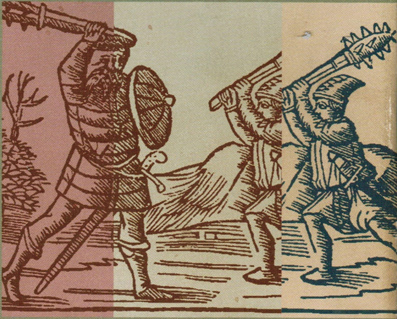 |
Peoples' movements and protests |
 |
|
MobilizationsSpanish comunerosDacke and French camisardsDutch CalvinistsEnglish PuritansThe Russian tradition of rebellionAndean peasantsThe jihad traditionBack to Tax revoltsBack to Old movementsBack to main page |
Nils Dacke and French camisards
The most common form of popular politics in early modern times – about 1500-1750 – was protests against the growing state interference in the life of the villages. At least in the richer Western Europe, the center of the transnational economy of modern times. On the outskirts, Eastern Europe and South America, they went on longer. The ruling tactics of regaining power after the late medieval popular movements were namely royal military dictatorship. There were many ways in which that could promote the misery of the peasants. Most typically, it was taxes and levies on all the kings’ wars that people turned against. But it could also be the accommodation of soldiers at the expense of the villages (triggering in the Finnish Club War of 1596, picture above). Or clumsy rules for how farmers must behave. This was often done by class alliances. It was not only the peasants who were affected, it also troubled more locally based members of the landowners, who lost power to the royal chancelleries. The great uprising that crushed the Spanish superpower and made Spain a great power among others, the Catalan uprising of 1640, turned against both taxes, laws and military accommodation, and those who rebelled were the whole Catalan society. The real home of such uprisings was France, where the royal dictatorship was more effective than anywhere else. In Aquitaine alone – the area around Bordeaux and Toulouse – peasants revolted more than five hundred times during the 17th century; the last – the so-called the revolt of the Camisards not far from there – took place in 1715. But otherwise they were a pan-European phenomenon with a peak around 1650. English peasants revolted against state control of the church in the 1530s and 50s. Peasants and townspeople in and around Naples made a revolution against the Spanish king in 1648. Swiss peasants revolted against the arrogance of cities in the 1650s. We Swedes remember a number of uprisings in Dalarna against new taxes. The most extensive uprising however, which was close to overthrowing the king, was the so-called Dacke revolt in Småland 1542-43. In addition to taxation, it also targeted the king’s attempt to introduce Roman law instead of the traditional one. The peasants turned mainly against the plundering of the property of the churches, i.e the parishes, as well as against the increasingly gross methods of the bailiffs. During the winter of 42-43, the rebel army controlled all of Småland and parts of Östergötland and the king was forced to start negotiations. The negotiation, however, turned out to be a scam – he secretly hired experienced German mercenaries who crushed the uprising later in the year. However, he felt compelled to back down from his demands and quietly abandoned attempts to change the legal system. And he also invited the peasants to following parliaments as a fourth estate, which was cheaper than forcing taxes by violence. Reading
|
